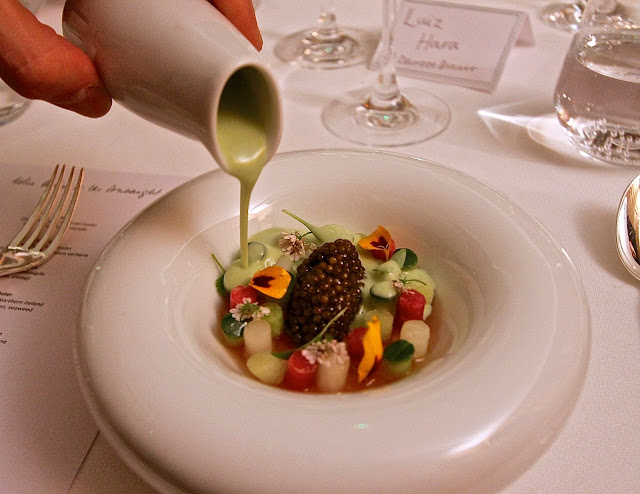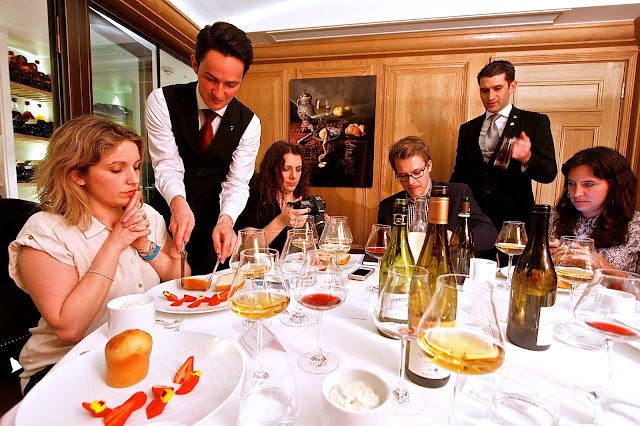Name: Boyds Grill & Wine Bar
Where: 8 Northumberland Avenue, London, WC2N 5BY, http://www.boydsgrillandwinebar.co.uk/
Cost: Hot and cold small eats are all priced at £5. Charcuterie and cheese platters for sharing between two cost £19.95. Grilled meat or fish main courses range from £14 to £50, with most being around the £15 to £20 mark. Side dishes are £4.
The wine list is comprehensive, with a focus on classic French regions, but with a good representation of wines from England, the rest of Europe and the New World. There is a good selection of wines by the glass. By the bottle, the entry-level white is a Solano Blanco 2014 from Galicia, Spain at £21.50. The red, at the same price point, is a Tarabilla Tinto 2014 also from Galicia. Prices ascend as far as the Cos d'Estournel 'Les Pagodes de Cos' 2009 at £192.50.
About: Situated on the ground floor of the The Grand Hotel, Trafalgar Square, Boyds Grill & Wine Bar is set in a sumptuous room, dating back to the origins of the hotel, with black and white marble walls and floors, and a glamorous copper-topped bar in the centre of the dining area.
The menu, designed by Executive British chef Nate Brewster, features an extensive range of grilled meats, all cooked on a high heat, eco-friendly Synergy Grill, which claims to retain the natural juices of the meat and give it an authentic barbecue charred flavour.
Signature dishes include a Tomahawk rib steak, served with two sides and two sauces (1.2kg, £70 to share), and braised short rib sandwich with caramelised onion, rocket and jus (£10.95).
There is a range of British meats to choose for the grill, including British Wagyu beef, Scottish Black Gold beef, Welsh lamb, Suffolk pork and Norfolk black chicken. For those with fish and seafood in mind, there is a selection of small plates and fish dishes.
If you get to visit Boyds Grill & Wine Bar, the Dessert Bar experience is not be missed – for £11.95 per person, the pastry chef will prepare (and demonstrate) up to 11 different types of ice cream and sorbet using liquid nitrogen, but more on that later.
What We Had: We started with a selection of small eats (£5 each) and a glass of fine Nyetimber Classic Cuvee 2010 (£10 per glass). The salmon tartare with avocado, mango and chilli was zingy, well seasoned and beautifully presented.
Equally good were the Mac n Cheese croquettes (with Wookey Hole cheddar), served with Boyds own bbq sauce. Crunchy on the outside but cheesy and delicious inside, I love Mac n’ Cheese in any shape or form, and these were no exception.
The duck liver parfait with crispy brioche, fig and mandarin meringue was also good – I particularly liked the citrusy, sweet meringue combined with the creamy liver parfait, a revelation.
I enjoyed the tongue-in-cheek fish and shellfish goujons deep-fried in beer batter and served with a curried hollandaise much like a posh chippy's curry sauce.
We were very impressed by the eclectic and surprisingly well priced wine list, we went a bit overboard on our choices. Accompanying our starters, we ordered 3 different whites: the Austrian Gruner Veltliner, Lossterrassen Weingut 2014 (£8.25 per glass) was a good example of its kind, with apricot and gooseberry flavours. The Croatian Primus Reisling, Bolfan 2012 (£7 per glass) was rich and off-dry, with green apple and mineral aromas. Best of all was the Puilly Fuisse 'Vieilles Vignes' 2014, from Domain Patriarche, Burgundy (£10.25 per glass) - made from 100% chardonnay, this was rich and concentrated with subtle tropical fruit aromas.
The starters were followed by a scrumptious meat platter (all Boyds meat comes from British farms), including pork chop (£17), Black Gold rib eye, lamb hogget (£18), and Wagyu minute steak. Lamb is a sheep aged up to 1 year, while the hogget is aged between 1 and 2 years (over 2 years it becomes mutton). The hogget had a great depth of flavour while still retaining the tenderness of lamb.
Boyds gets its Wagyu from Sussex, where native cows have been crossed with Red Wagyu from Australia and the USA. The final product is a 28 day dry-aged, beautifully marbled and tender cut of beef.
Sides (£4 each) were assorted seasonal vegetables, Parmesan fries and triple cooked sweet potato wedges, served with lemon, thyme and Port jus, and a Béarnaise sauce (£1.95 each). The Parmesan fries were among the finest chips I have ever had the pleasure of eating - light, fluffy, crisp and cheesy all at the same time.
With the meats, we had an outstanding glass of Gevrey Chambertin 'Vieilles Vignes' 2011 from Domain Gerard Seguin (£67 per bottle). Refined and elegant, this had delicate redcurrant fruit and a surprisingly long finish.
The Chateauneuf du Pape 'Le Calice de St-Pierre' 2014 (£47 per bottle) was altogether more robust as would be expected from this hot climate area, and more than a match for the richer meats, with black berry fruit and a good grip of tannin.
One of my favourite red wines is Chateau Musar 2007, from the Bekaa Valley, Lebanon (£61 per bottle). This was an excellent vintage, with brambles, plums, leather, tobacco and just a hint of mushroom.
After dinner, there is an option for diners to have the Dessert Bar Experience (£11.95 per person), where some amazing ice creams are rustled up to order.
The Dessert Bar experience includes up to 11 different ice creams and sorbets, from a mind-boggling array of fruit creams and purées, where guests are invited to select their favourite flavours. They are then mixed with liquid nitrogen at -190 degrees centigrade, to create an amazingly light and airy ice cream. The Dessert Bar Experience can also be enjoyed on its own, without any requirement to eat dinner at the restaurant.
We started with “Dragon's Breath” – a selection of flavoured, superchilled meringues that literally froze the breath, followed by the ice creams.
Some highlights were intensely flavoured and creamy blackberry and raspberry ice creams. The Jack Daniels ice cream came on a classic vanilla base, while the lemon sorbet made with Limoncello was mouthwateringly refreshing.
We went on to have some increasingly unusual flavours - why go for vanilla when you can have smoked strawberry, smoky bacon, English breakfast tea, canned pork and picallilli, dill and cream cheese, and even smoked salmon and wasabi!
With dessert, we had a chilled and creamy cocktail of Baileys, Sambuca and Espresso that went down a treat.
Likes: Trafalgar Square location, elegant dining room, fantastic chips, a great selection of grilled beef, Wagyu and other meats. The small eats are well made and very reasonably priced. Loved the Dessert Bar Experience!
Dislikes: None
Verdict: A perfect meal for me at Boyds Grill and Wine Bar starts with their Black Gold rib eye accompanied by the scrumptious Parmesan chips and a large glass of 2007 Chateau Musar. The Dessert Bar is an experience not to be missed, and is worth a trip to the restaurant in its own right. I cannot wait to return. Highly recommended.




































































